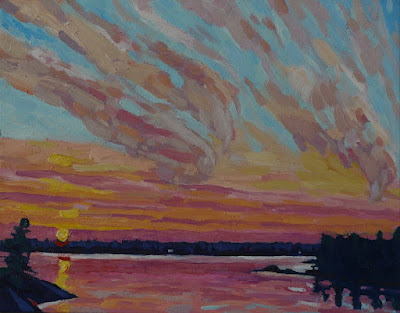 |
| #2725 "Sunset on American Thanksgiving 2022" 11x14 inches oils on canvas |
This is the American Thanksgiving sunset at 4:18 pm Thursday, November 24th, 2022. It was almost a summer's day and I enjoyed most of it outside. The bands of cirrus stretching in the deforming flow aloft revealed that a rain system was emerging from the Gulf of Mexico. The cirrus clouds were at multiple levels. The highest clouds to the west were still catching the setting sun. There were atmospheric swells and deformation zones mixed up with those lines in the sky.
 |
| Speed Decrease in the Atmospheric Frame of Reference causes wind perpendicular deformation zones |
Within the atmospheric frame of reference, a decreasing wind speed requires deformation zones perpendicular to the direction of the flow.
 |
| Speed Increase in the Atmospheric Frame of Reference causes wind parallel deformation zones |
If the speed of the flow increases, the deformation zones must parallel the direction of the flow.
The fingers of your Coriolis Hand when aligned with the curl of the cloud reveals if the moisture is associated with the cyclonic or anticyclonic companions of the atmospheric flow. The accompanying graphics illustrate the science that applies globally.
 |
| The Conveyor Belt Conceptual Model |
- Load the brush;
- Drop the paint in one sweep;
- Move on.
For this and much more art, click on Pixels.
Warmest regards and keep your paddle in the water,
Phil Chadwick

























